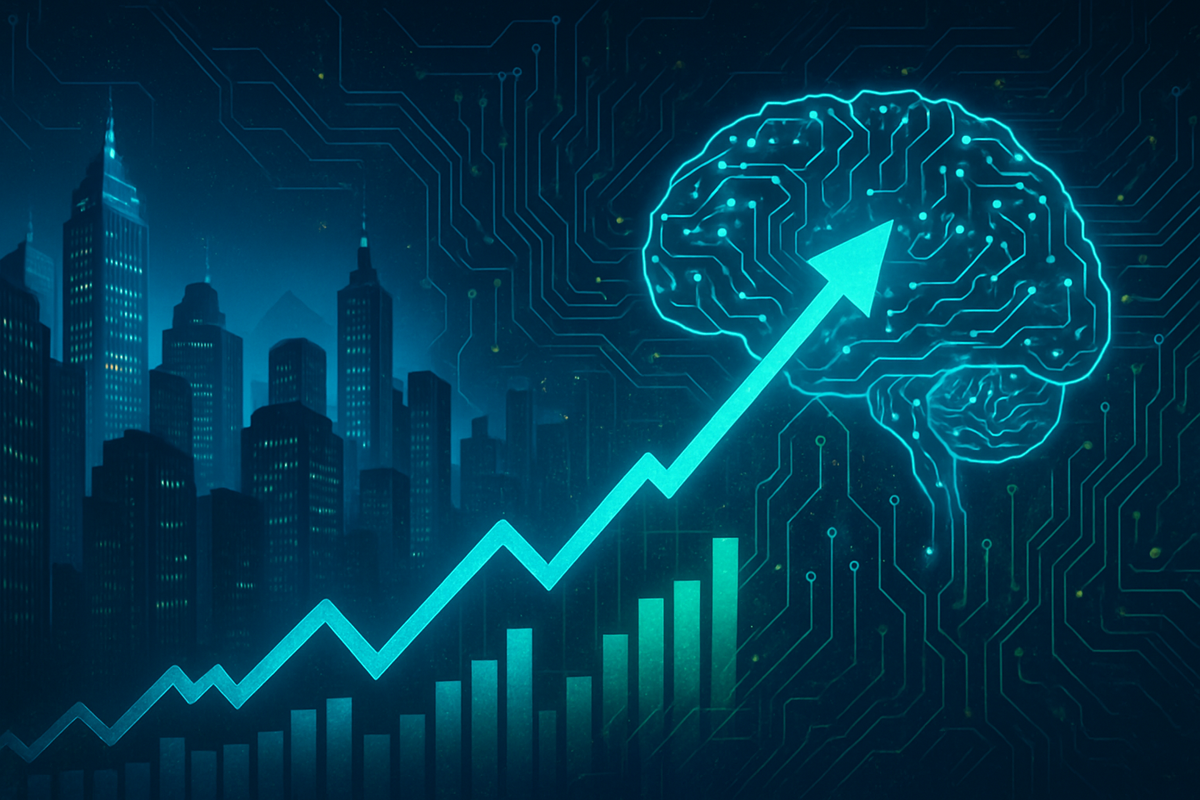
Wall Street is currently experiencing an extraordinary bull run, with major indices shattering previous records as the financial markets surge into uncharted territory. This remarkable ascent, as of October 2025, is overwhelmingly powered by the technology sector, which continues to demonstrate robust growth and innovation. At the heart of this expansion lies the burgeoning field of Artificial Intelligence (AI), acting as the primary catalyst for investor enthusiasm and corporate profitability. Despite a recent U.S. government shutdown that has introduced a degree of domestic political uncertainty, the market has shown remarkable resilience, largely looking past immediate political gridlock to focus on the transformative potential of long-term technological trends and the anticipated continuation of accommodating monetary policies.
This period of sustained growth reflects a profound shift in market dynamics, where groundbreaking technological advancements are not just incremental improvements but foundational changes driving economic expansion. The confluence of innovative AI applications, strategic investments by leading tech firms, and a favorable interest rate environment orchestrated by the Federal Reserve has created a powerful updraft, carrying the market to new all-time highs. Investors are increasingly prioritizing companies that are at the forefront of AI development and deployment, recognizing their potential for significant future earnings and market dominance.
The AI-Fueled Ascent: A Detailed Look at Wall Street's Record Run
The financial markets have been on an impressive trajectory, with both the S&P 500 and the Dow Jones Industrial Average recently achieving all-time highs. The S&P 500, a key benchmark for the broader market, has notably recorded seven winning weeks out of the last nine, signaling strong and consistent investor confidence. The Nasdaq Composite (NASDAQ: COMP), heavily weighted towards technology and growth stocks, has also set new records, underscoring the tech sector's pivotal role in this rally. This upward momentum has been significantly bolstered by optimism surrounding the Federal Reserve's monetary policy, which initiated its first interest rate cut of the year in September, with further reductions widely anticipated before the close of 2025. This expectation has served to enhance investor sentiment, allowing the market to largely discount domestic political disruptions, such as the ongoing government shutdown.
Looking at the timeline, the third quarter of 2025 saw stocks climb an impressive 8%, accompanied by a rally in bond prices as yields fell, a direct reaction to the Fed's rate cut. By late August 2025, the Information Technology sector had gained a substantial 14.0% year-to-date, while the tech-related Communication Services sector surged by 17.9%. These figures significantly outpaced the S&P 500's (NYSEARCA: SPY) 10.8% return and the NASDAQ Composite's 11.6% return for the year, clearly illustrating where the market's strength lies. The "Magnificent Seven"—comprising Meta Platforms (NASDAQ: META), Nvidia (NASDAQ: NVDA), Tesla (NASDAQ: TSLA), Apple (NASDAQ: AAPL), Microsoft (NASDAQ: MSFT), Amazon (NASDAQ: AMZN), and Alphabet (NASDAQ: GOOGL)—continue to exert unparalleled influence, owing to their massive market capitalizations and relentless pursuit of innovation.
Artificial Intelligence remains the undisputed engine of earnings growth within the technology sector. Big Tech companies are demonstrating an exceptional ability to monetize AI, particularly through the expansion of their cloud services. Companies deeply invested in AI infrastructure, especially within the semiconductor industry, have reported outstanding results throughout 2024 and into 2025. For instance, Palantir Technologies Inc. (NYSE: PLTR) has seen a staggering 391.21% increase in its one-year returns as of October 1, 2025, driven by its leadership in AI-driven data collection. Broadcom Inc. (NASDAQ: AVGO) also posted a robust 90.25% one-year return. Advanced Micro Devices (NASDAQ: AMD) experienced a dramatic surge of over 32% on October 6th, following the announcement that OpenAI would integrate its chips into its AI infrastructure. Nvidia (NASDAQ: NVDA), often celebrated as the "poster child of the AI boom," maintains its dominant position in AI infrastructure, with analysts projecting a potential $10 trillion valuation by 2030, attributed to its comprehensive suite of GPUs, CPUs, interconnects, and the CUDA software platform. Microsoft (NASDAQ: MSFT) is strategically leveraging AI through its Azure cloud services, contributing to strong revenue growth and significant capital expenditures dedicated to expanding data centers to support AI advancements.
The immediate market reaction to these developments is one of cautious optimism. While the strong fundamentals, profitability, and competitive advantages of these leading tech firms differentiate the current market from past speculative bubbles, the rapid "frenzy around AI" has prompted some concerns about potentially overvalued prices. However, many analysts contend that the robust earnings and strategic investments of these companies provide a more solid foundation. With the U.S. government shutdown delaying official economic data releases, market participants are closely monitoring insights from Federal Reserve officials and private economic indicators. The impending third-quarter earnings season, featuring reports from major companies, will serve as a critical barometer for market sentiment, with strategists forecasting positive surprises that could further fuel the rally.
The Winners and Losers in the AI-Driven Market
The current technology-led market rally has created a clear delineation between companies that are poised for significant gains and those that may struggle to keep pace. Unsurprisingly, the primary beneficiaries are the tech giants and specialized firms deeply entrenched in the Artificial Intelligence ecosystem, particularly those involved in semiconductor manufacturing, cloud computing, and AI software development.
Leading the charge are companies like Nvidia (NASDAQ: NVDA), whose comprehensive AI hardware and software platforms make it indispensable to the industry. Its GPUs are the backbone of most AI training and inference operations, positioning it for continued exponential growth. Similarly, Advanced Micro Devices (NASDAQ: AMD) is rapidly gaining ground, especially with strategic partnerships like the one with OpenAI, signaling its increasing relevance in the AI chip market. Microsoft (NASDAQ: MSFT), through its Azure cloud services and significant investments in AI research and integration across its product suite, is another major winner, leveraging AI to drive cloud revenue and enhance enterprise solutions. Alphabet (NASDAQ: GOOGL), with its Google Cloud and diverse AI initiatives, and Amazon (NASDAQ: AMZN), via AWS and its expanding AI services, are also capitalizing on the demand for AI infrastructure and applications. Palantir Technologies Inc. (NYSE: PLTR) stands out for its specialized AI-driven data analytics platforms, which have seen massive adoption across government and enterprise sectors, driving its exceptional stock performance.
Conversely, companies that are slow to adopt AI, or whose business models are disrupted by AI-powered solutions, face significant challenges. Traditional industries that rely on manual processes or offer services that can be automated or optimized by AI may see their competitive advantages erode. Companies with less robust R&D budgets might struggle to innovate at the pace of the market leaders, potentially losing market share. Furthermore, while the market is broadly optimistic, some analysts express concerns about the sustainability of valuations for certain "AI pure-play" startups that lack strong underlying fundamentals or clear paths to profitability. These firms, if their speculative growth does not materialize into concrete earnings, could experience significant corrections. The capital expenditures required to compete in the AI space are enormous, putting smaller, less capitalized tech firms at a disadvantage unless they possess highly specialized, indispensable technology.
The ripple effect extends to companies whose products or services become less relevant in an AI-dominated world. For instance, businesses that offer generic software solutions without AI integration may find themselves outcompeted by more intelligent, adaptive alternatives. Even within the tech sector, companies that fail to pivot towards AI-driven offerings risk stagnation. This dynamic is fostering an environment where innovation is not just an advantage, but a necessity for survival and growth, creating a stark contrast between the booming AI innovators and those struggling to adapt.
Broader Significance: Reshaping Industries and Regulatory Landscapes
The current AI-driven surge in the stock market is not merely a financial phenomenon; it represents a profound shift with wider significance across industries, regulatory frameworks, and geopolitical dynamics. This event fits squarely into broader industry trends emphasizing digital transformation, automation, and data-driven decision-making, but with AI now acting as the accelerating force. The rapid advancements in AI are creating entirely new markets while simultaneously disrupting established ones, forcing companies across all sectors to re-evaluate their strategies.
The potential ripple effects on competitors and partners are immense. For competitors, the imperative is clear: innovate or risk obsolescence. Companies that do not invest heavily in AI research and development, or fail to integrate AI into their core operations, will find it increasingly difficult to compete with the efficiency, personalization, and predictive capabilities offered by AI-powered rivals. This pressure could lead to a wave of mergers and acquisitions, as smaller firms with valuable AI intellectual property become attractive targets for larger entities seeking to bolster their capabilities. Partners, too, are being pushed to adapt, with supply chains and collaborative ecosystems increasingly optimized by AI, demanding greater data integration and algorithmic efficiency.
From a regulatory and policy perspective, the rapid rise of AI giants and their expanding influence is drawing significant scrutiny. Governments worldwide are grappling with how to regulate AI to ensure ethical development, prevent monopolies, protect data privacy, and address potential job displacement. Antitrust concerns are particularly salient, especially regarding the "Magnificent Seven," whose dominance in cloud computing, data, and AI infrastructure could be seen as stifling competition. Discussions around data governance, algorithmic bias, and the responsible use of AI are becoming central to legislative agendas, potentially leading to new laws and stricter oversight that could impact the operational freedom and profitability of these tech behemoths. The U.S. government shutdown, while seemingly unrelated, highlights the broader political environment where such regulatory debates are taking place, potentially delaying critical policy decisions.
Historically, this period draws comparisons to previous technological revolutions, such as the dot-com boom of the late 1990s or the advent of the internet itself. However, a key distinction, as noted by analysts, is that today's leading AI companies possess robust fundamentals, substantial earnings, and clear pathways to monetization, unlike many speculative ventures of the dot-com era. This suggests a more sustainable growth trajectory, though concerns about market bubbles persist due to the rapid pace of valuation increases. The current environment also echoes the rise of industrial titans in the early 20th century, where technological innovation fundamentally reshaped the economy, leading to both immense wealth creation and calls for regulatory intervention to ensure fair competition and societal benefit.
What Comes Next: Navigating the Future of an AI-Driven Market
Looking ahead, the trajectory of Wall Street and the broader economy will largely hinge on the continued evolution of AI and the market's response to both its opportunities and challenges. In the short-term (late 2025 to early 2026), the market is widely expected to sustain its bullish momentum, primarily fueled by ongoing AI developments and the anticipated continuation of the Federal Reserve's rate-cutting cycle. This environment is likely to keep investor confidence high, particularly in the tech sector. However, the upcoming third-quarter earnings season will be a crucial test, providing concrete data on how effectively companies are translating AI investments into revenue and profit. Any significant misses could introduce volatility, while strong beats could further propel the rally.
Long-term possibilities (2026 and beyond) suggest a continued restructuring of industries as AI becomes even more pervasive. Companies that successfully integrate AI into their core operations and develop innovative AI-powered products and services will likely emerge as dominant players across various sectors, not just technology. This could lead to a re-evaluation of traditional industry classifications as AI blurs the lines between tech and non-tech businesses. Potential strategic pivots or adaptations required for companies will involve not just adopting AI, but fundamentally rethinking business models, workforce training, and competitive strategies to leverage AI's full potential. This might include significant investments in data infrastructure, talent acquisition in AI, and fostering a culture of continuous innovation.
Market opportunities will emerge in new niches created by AI, such as specialized AI ethics consulting, AI-driven cybersecurity solutions, and advanced robotics. Furthermore, sectors like healthcare, finance, and manufacturing are ripe for AI-driven transformation, presenting significant investment opportunities. However, challenges will also emerge, including the potential for increased regulatory scrutiny on AI, ethical dilemmas surrounding its use, and the need to address the societal impact of automation, such as job displacement. The "frenzy around AI" also carries the inherent risk of overvaluation, and a market correction remains a possibility if growth expectations become detached from fundamental performance.
Potential scenarios and outcomes range from a sustained, healthy growth driven by genuine AI innovation and productivity gains, to a more speculative bubble that eventually deflates if profitability fails to keep pace with valuations. Another scenario involves a more fragmented market, where a few dominant AI players consolidate power, while others struggle to compete. Investors should prepare for continued volatility, driven by both technological breakthroughs and potential regulatory headwinds. The interplay between technological innovation, corporate strategy, and governmental policy will be critical in shaping the market's future.
Comprehensive Wrap-Up: Navigating the New Era of Market Growth
In summary, Wall Street is currently riding an unprecedented wave of growth, with major indices reaching new record highs, overwhelmingly propelled by the technology sector. The advent and rapid integration of Artificial Intelligence (AI) stand as the primary catalyst for this remarkable expansion, distinguishing the current market from previous speculative booms due to the robust fundamentals and clear monetization strategies of leading tech firms. Companies like Nvidia (NASDAQ: NVDA), Microsoft (NASDAQ: MSFT), and Alphabet (NASDAQ: GOOGL) are at the forefront, leveraging AI to drive significant earnings and market capitalization. While the market has shown resilience in the face of political uncertainties like the U.S. government shutdown, it remains acutely focused on technological advancements and the Federal Reserve's accommodative monetary policy.
Moving forward, the market is poised for continued dynamism, with AI set to reshape industries and redefine competitive landscapes. The key takeaway for businesses and investors alike is the undeniable imperative to embrace AI, not merely as a tool, but as a foundational element of future growth and innovation. Companies that fail to adapt and integrate AI into their core strategies risk falling behind, while those that strategically invest and innovate are likely to reap substantial rewards. The ongoing debate around AI regulation and ethical considerations will also play a crucial role, potentially influencing market dynamics and corporate strategies.
Final thoughts on the significance of this period underscore its transformative potential. This is more than just a market rally; it's a structural shift driven by a technology with the power to enhance productivity, create new markets, and solve complex global challenges. The lasting impact will be a more technologically integrated economy, where data and intelligence are paramount. Investors should watch closely for the upcoming earnings reports, further developments in AI technology, and any shifts in monetary policy or regulatory frameworks. The ability of companies to demonstrate tangible returns from their AI investments will be critical. Furthermore, monitoring the broader economic indicators, especially in light of potential government policy changes, will be essential for making informed investment decisions in the months to come.
This content is intended for informational purposes only and is not financial advice





